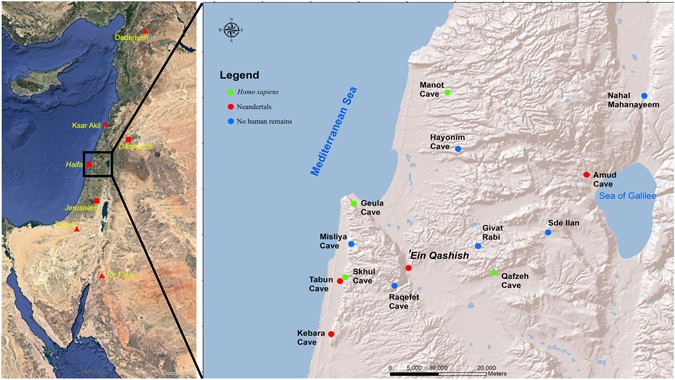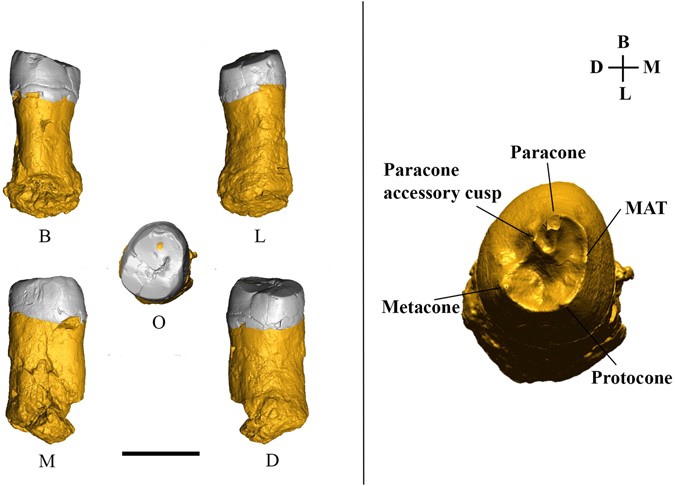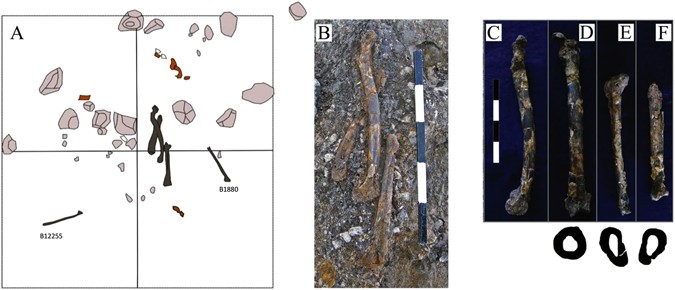|
|
Post by Admin on Jun 11, 2017 19:21:03 GMT
 In analyzing the first Neanderthal remains found outside caves in the Levant, researchers have found Neanderthals were not merely “cavemen,” but much more flexible in their living habits than commonly held. As part of major road construction, archaeologists were called in by road company Derekh Eretz Inc. to survey the northern Israel site of Ein Qashish, situated on the banks of the Kishon River. The findings of their study — published Wednesday in the journal Nature Scientific Reports — indicate that 60,000 years ago, as modern humans reached the region, Neanderthals in the Levant inhabited both caves and open landscapes. The Levant, or Near East, is to date the only known region where the fossil record shows the two populations — Neanderthals and Homo sapiens– existed simultaneously during the Middle Paleolithic era. Unlike earlier studies, however, this survey includes fossils of both types of human individuals — not only from caves, but also from open-air sites. “The discovery of Neanderthals at open-air sites during the late MP reinforces the view that Neanderthals were a resilient population in the Levant shortly before Upper Palaeolithic Homo sapiens populated the region,” the article stated.  The study was led by Dr. Ella Been from the Ono Academic College, Prof. Erella Hovers from the Institute of Archaeology of the Hebrew University of Jerusalem and Dr. Omry Barzilai from the Israel Antiquities Authority, with the assistance of Dr. Ravid Ekshtain (the Hebrew University of Jerusalem) and Dr. Ariel Malinsky-Buller (the Museum for Human Behavioral Evolution, Monrepos, Germany) Aided by advanced imaging and statistical techniques, the archaeologists used a single upper molar tooth to represent the remains of one Neanderthal. The second Neanderthal was represented by the lower limbs of an individual who suffered from injuries that likely caused limping. The remains were found within a rich archaeological level containing flint tools, animal bones, and some unusual finds for the period, such as a marine shell, pigments and an antler of a deer, according to the Israel Antiquities Authority.  The findings of the study go a long way toward explaining the disappearance of the Neanderthals, according to the IAA. Whereas traditional explanations hypothesize that Neanderthals in the Near East were unable to adapt to an increasingly dry climate, the Ein Qashish finds indicate that they were adapted to open-air living. “Our study suggests that Neanderthals were a resilient population that successfully existed in the north of Israel at the time that modern humans arrived from Africa some 60,000 years ago.” |
|
|
|
Post by Admin on Jun 12, 2017 20:02:02 GMT
 The Middle Palaeolithic (MP) of the southern Levant is a significant period for the study of human evolution because two types of hominins, Neandertals and Homo sapiens, occupied the region at that time (see, for example, refs 1 and 2). Diagnostic fossil remains of the two species have been found in the Mediterranean woodland region, but until recently, they were discovered only at cave sites (Fig. 1). The absolute chronology of the Levantine MP fossils indicates that H. sapiens existed there between 120 and 90 ka and again from 55 ka on; Neandertals existed in that region between ca. 80 and ca. 55 ka3,4,5,6,7,8,9,10,11,12,13,14,15,16. The genomic evidence suggests gene flow from early H. sapiens to the eastern Altai Neandertals ca. 100 ka17 and flow from Neandertals to H. sapiens between ca. 60 and 50 ka18. In the Levant, the archaeological record cannot distinguish between these two MP populations. The lithic variability observed in the Levantine MP is not clearly taxonomy related (ref. 19 for a different view see ref. 20). The two populations left similar material culture remains—in particular, lithic industries that include the Levallois technology. In addition, the populations seem to have had similar settlement and mobility patterns in respect to the use of caves for habitation and burials; at Tabun, these populations used the same cave diachronically12, 13, 21, 22.  Figure 1 Left: Major Middle Palaeolithic sites (triangles) and modern cities (squares) in the Near East. Right: Location of ‘Ein Qashish and other Middle Palaeolithic sites in northern Israel. The map was generated using ESRI ArcInfo v10.4. The discovery of several previously unknown MP open-air sites in the Mediterranean woodland region in the last decade diverted much of the research focus to MP behaviors associated with the open landscape (e.g., ref. 23). In the absence of taxonomically informative fossil remains, it was impossible to attribute these (as well as previously reported) open-air sites to either Neandertals or H. sapiens. Therefore, it was also difficult to determine these species’ settlement patterns and territorial behavior within the Levant. The new discovery of Neandertal remains at the late MP open-air site of ‘Ein Qashish provides a window into the settlement and mobility patterns of the Neandertals of northern Israel. ‘Ein Qashish is located on the south bank of the Qishon stream in the Jezreel Valley, facing the eastern slopes of Mount Carmel, Israel (Fig. 1). Excavations at the site in 2009–2011 exposed remains of a Late Mousterian occupation on the Qishon floodplain24,25,26,27,28. |
|
|
|
Post by Admin on Jun 13, 2017 19:22:58 GMT
 Figure 2 Schematic plan of ‘Ein Qashish. (A) Compiled stratigraphic section with vertical locations of OSL dates, in thousands of years, and hominin fossils. (B) Plan of excavation areas with spatial locations of hominin fossils. The Context of the Hominin Remains The hominin remains from ‘Ein Qashish represent three individuals that were found in three distinct layers (Fig. 2). Specimen EQH1 is a nondiagnostic skull fragment that was discovered in a mechanically dug geological trench prior to the 2013 excavation (ref. 29; SI 1). The stratigraphic position of the fossil corresponds to Layer 1, the lowest in the documented sections in the site’s vicinity. Layer 1 is absent from the sequence in the archaeological excavation itself (N. Greenbaum, pers. obs.). Contextual data for the layer are poor. The second fossil, EQH2, is an upper third molar (Fig. 3) from Layer 5a, in Area A. The fossil was found associated with flint artefacts and faunal remains in a horizon with refitted lithic items (51 refitted items in 21 aggregates) (SI 1), indicating a moderately disturbed in situ context.  Figure 3 3D digital model of specimen EQH2, an upper right third molar. Left: Various views—B, buccal; L, lingual; M, mesial; D, distal; O, occlusal. The black bar represents 1 cm. Right: The enamel-dentine junction (EDJ) surface of EQH2. The best-preserved specimen is EQH3, consisting of five lower limb bones—a femur, two tibiae, and two fibulae (Fig. 4)—associated with an occupational horizon in stratigraphic Layer 3b, Area B (for details of the archaeological context, see SI 1). The femur and the left tibia of EQH3 were found articulated. The bones were aligned along the same axis, with the right tibia parallel to the left (Fig. 4A,B). One of the two fibulae (B1880) was discovered ca. 50 cm north of the femur-tibia cluster, and the other fibula (B12255), ca. 70 cm south of the cluster (Fig. 4A). Finds other than human remains in this particular horizon comprise fresh flint artefacts (with 21 refitted items from four aggregates); fragmented animal bones; limestone clasts, including potential manuports (possibly anvils); ochre; a roe deer antler and a seashell, Hexaplex trunculus (Linnaeus, 1758) (SI 1). OSL dating of sediments directly above and below EQH3 puts the fossil at 65 ± 8 ka (SI 2). |
|
|
|
Post by Admin on Jun 15, 2017 19:16:13 GMT
 Figure 4 Specimen EQH3. (A) The spatial location of the five lower limb bones of EQH3 (dark brown); specimens B1880 and B12255 are fibulae. Pink: stones; reddish-brown: faunal remains. (B) The bones in situ. Note the partial articulation of the left femur and left tibia. (C) Left femur, medial view. (D) Left femur, anterior view; midshaft cross section (underneath). (E) Left tibia, anterior view; midshaft cross section (underneath). (F) Right tibia, anterior view; midshaft cross section (underneath). EQH2 EQH2 is an upper right third molar (RM3) on which both the crown (with a mesiodistal [MD] length of 8.3 mm and buccolingual [BL] length of 9.7 mm) and the root (with a length of 14.3 mm) are preserved. The moderate wear of the tooth, with the dentine exposed on the paracone cusp, corresponds to wear stage (category) 3 of Molnar’s dental attrition classification30. In an occlusal view, the crown outline is oval, and although tooth wear has removed most of the occlusal features, three main cusps (the protocone, paracone, and metacone) can be identified (Fig. 3, right). At the enamel-dentine junction (EDJ) (Fig. 3, right; SI 3 Table 1), two accessory cusps (the mesial accessory tubercle [MAT] and paracone accessory cusp) are present, but there is no trace of the distolingual cusp (the hypocone) or Carabelli’s cusp. An interproximal wear facet (length, 3.81 mm; width, 4.19 mm) is visible only on the mesial side of the tooth (Fig. 3, left). The tooth is hypertaurodontic and does not show root bifurcation. We compared the MD and BL crown diameters of EQH2 to the diameters in tooth samples from Neandertals, early H. sapiens, Upper Palaeolithic H. sapiens, and recent H. sapiens (SI 3 Table 2; SI 3 Fig. 1). There is a large overlap in the distribution of the MD and BL diameters in our comparative sample. The values obtained for EQH2 are the lowest among the fossils and are closest to the values obtained for the Neandertal specimens Saccopastore 1, Amud 1, and Tabun 1 and the Upper Palaeolithic H. sapiens specimen Kostenki XIV (SI 3 Fig. 1). With regard to the relative enamel thickness (RET) index, the z score computed for the EQH2 RET value (18.9) is closer to the Neandertal mean than to the means of early, Upper Palaeolithic, and recent H. sapiens (SI 3 Tables 3, 4). Dental tissue volumes and root measurements of EQH2 and the comparative sample (SI 3 Fig. 2; SI 3 Tables 4, 5) show that the root of EQH2 is somewhat larger than in the comparative sample. The computed z score for EQH2’s root length, total root volume, pulp volume, and root pulp volume is closer to that of the Neandertals, whereas the coronal pulp volume is closer to that of Upper Palaeolithic H. sapiens and the cervical plane area is closer to that of recent H. sapiens. The cross-validation linear discriminant analysis of four root variables (root length, root volume, pulp volume, and cervical plane area) shows that 23 modern humans (92% of our sample) and all Neandertals in our sample were correctly classified and attributes EQH2 to H. neanderthalensis with a Ppost of 70%. Note that if we remove the cervical plane area from the analysis, EQH2 is attributed to H. neanderthalensis with a Ppost value of 81%. EQH3 The lower limb bones of EQH3 consist of a left femur, two tibiae, and two fibulae. Out of the five lower limb bones, only the femur and two tibiae are preserved enough for analysis (Fig. 4C–F). The femur is essentially complete (Fig. 4). The femoral shaft is highly curved on the sagittal plane (i.e., anteroposteriorly), with the apex of the curvature located distal to the midshaft. The midshaft shape ratio (with a pilastric index of 99.1) indicates a rounded cross section (the anteroposterior diameter and mediolateral diameter are nearly equal) (Fig. 4; SI 4 Table 3). The midshaft robusticity index (14.9) indicates a highly robust femur. The midshaft cross-sectional area is large, with a relatively high percentage of cortical bone. All of these features are well-documented Neandertal characteristics that differ considerably from the more gracile femur of early and recent H. sapiens. There, the midshaft has a drop-shaped cross section and is straight compared to that of the Neandertals31,32,33,34,35,36 (SI 4). The distal epiphysis of the EQH3 femur is relatively small, and the intercondylar fossa is extremely narrow, a feature that is not usually seen in either H. sapiens or Neandertals (SI 4). The remains of the right tibia include the diaphysis distal to the soleal line and the distal epiphyses; the proximal part of the tibia is missing (Fig. 4). Nearly complete, the left tibia is missing only its medial malleolus. The tibial plateau is flat, with a robust intercondylar tubercle (the medial part of the intercondylar eminence). |
|
|
|
Post by Admin on Jun 16, 2017 19:04:53 GMT
 Discussion The absolute dating of contexts associated with the Neandertal fossils from Tabun, Dederiyeh, Kebara, and Amud Caves suggests that Neandertals occupied the southern Levant between ca. 80 and ca. 55 ka3, 6, 10, 12, 13, 45. Because diagnostic hominin remains from open-air sites dated to this period were not available until now (e.g., refs 46 and 47), attributing the occupation of open-air sites to Neandertal settlement systems called for caution. However, the fossils EQH2 and EQH3 derive from two distinct stratigraphic horizons, and their associated OSL ages suggest that the open-air site of ‘Ein Qashish was used repeatedly by Neandertals from 70 to 60 ka, a period contemporary with the occupation of the Kebara and Amud Caves. The discovery of diagnostic Neandertal remains at the open-air site of ‘Ein Qashish is unusual not only for the Levant but also for Europe, where only two sites, both of which are earlier, have yielded such diagnostic fossils: the French Tourvillel a Rivière and Biache Saint Vaast 2 sites, both dated to marine isotope stage 748, 49.  The recovery of the two Neandertal fossils from ‘Ein Qashish raises questions as to the nature of their depositional histories and the inhabitants’ behavioral patterns. Whereas the tooth (EQH2) does not constitute a compelling indication of death at the site, the preservation of bones of two legs, as well as their partial articulation, suggests that the individual represented by EQH3 is likely to have died at the site or nearby. Given the bone state of preservation and articulation, the body remains must have been buried rather fast, either anthropogenically or naturally. The presence of Neandertal fossil remains at MP sites can be interpreted as the result of intentional burial or non anthropogenic deposition (e.g., refs 50 and 56). To determine which of the scenarios applies to the ‘Ein Qashish fossils, we evaluated several parameters that may distinguish between the two scenarios: articulation, flexed position, evidence of an excavated pit, intentional coverage of the bones, and the presence of grave goods. Given the available evidence, we cannot determine whether EQH3 is a burial or not. The partial articulation of the left femur and tibia, which attests to a flexed position of the knee (Fig. 4), may support a hypothesis of intentional burial. On the other hand, there are no other body parts of the individual, no visible indication of a pit or the intentional covering of a corpse, and no grave markers. A number of uncommon finds (a seashell, roe deer antler, and ochre) that were unearthed in the same archaeological horizon are not directly associated with the bones of EQH3.  The most informative aspect of the discovery of EQH3 is that it is a Neandertal. The stratigraphic association with a diverse set of material culture remains indicates a habitation context, and the stratigraphic sequence suggests that the locality was used repeatedly. The identification of EQH2 and EQH3 enables us, for the first time, to confidently attribute to Neandertals a set of assemblages from an open-air site in the southern Levant. This discovery in the flat topography of the palaeo-Qishon flood plain demonstrates that locomotor traits did not necessarily constrain Neandertals from exploiting landscapes other than the rugged mountainous terrain (contra57; see also ref. 58) and, by extension, the ecological mosaic of topographically diverse environments. Hypotheses regarding the demise of the Levantine Neandertals implicate competitive exclusion, direct competition1, 59, and the inability of the Neandertals to adapt to climate variability and deterioration (e.g., ref. 60). Recent studies focusing on various proxies from Kebara and Amud Caves show that climate change in the Mediterranean zone during the MIS 4 to early MIS 3 time span may not have been as drastic as suggested61 and that behavioral strategies enabled the Neandertals to cope with ecological change62, 63. Combined with the dates of the Kebara and Amud Neandertals, the repeated occupation of ‘Ein Qashish in the open landscape during the Levantine late MP reinforces the view that despite possible early interbreeding events17, Neandertals constituted a resilient population in the Mediterranean ecological zone of the southern Levant shortly before the region was populated by Upper Palaeolithic H. sapiens12,13,14, 16, 21, 64. Scientific Reports 7, Article number: 2958 (2017) |
|











